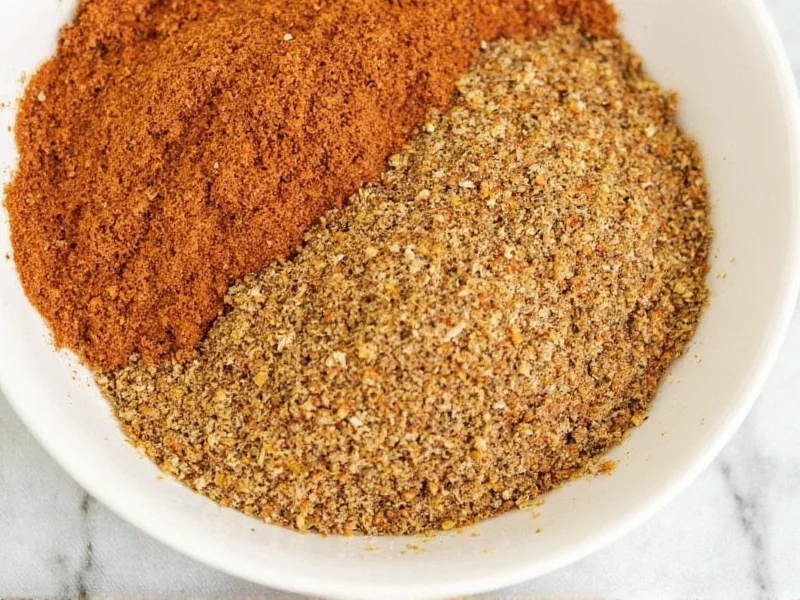Creating a perfect homemade chicken seasoning mix gives you complete control over ingredients and flavor intensity. Unlike store-bought versions that often contain fillers and excessive sodium, a DIY blend lets you adjust spice levels and avoid unwanted additives. The basic formula balances savory, aromatic, and subtle heat elements to complement chicken's natural flavor without masking it.
Essential Ingredients for Chicken Seasoning Mix
The foundation of an excellent chicken seasoning blend consists of pantry staples that work synergistically. Each component serves a specific purpose in building complex flavor profiles. Understanding these roles helps you customize your mix while maintaining balance.
| Ingredient | Primary Function | Flavor Contribution |
|---|---|---|
| Paprika | Color and mild sweetness | Earthy, slightly sweet base note |
| Garlic powder | Savory depth | Pungent, umami-rich backbone |
| Onion powder | Complex sweetness | Mellow, rounded savory note |
| Dried thyme | Herbal complexity | Earthy, slightly floral accent |
| Black pepper | Heat and brightness | Sharp, warming finish |
Basic Homemade Chicken Seasoning Mix Recipe
This simple chicken seasoning blend recipe creates approximately ¼ cup of seasoning—enough to flavor four chicken breasts or one whole chicken. The proportions provide balanced flavor without overwhelming the meat.
Ingredients
- 2 tablespoons paprika (smoked or sweet)
- 1 tablespoon garlic powder
- 1 tablespoon onion powder
- 1½ teaspoons dried thyme
- 1½ teaspoons dried oregano
- 1 teaspoon fine sea salt
- ½ teaspoon freshly ground black pepper
- ¼ teaspoon cayenne pepper (optional)
Preparation Method
Combine all ingredients in a small bowl, whisking thoroughly to ensure even distribution. For best results, store in an airtight container away from light and heat. This simple chicken seasoning from scratch requires minimal effort but delivers restaurant-quality results.
Variations for Different Flavor Profiles
Customizing your chicken seasoning mix accommodates various dietary preferences and meal types. These variations maintain the core structure while introducing distinctive characteristics:
- Lemon-Herb Chicken Seasoning: Add 1 teaspoon dried lemon zest and increase thyme to 2 teaspoons for bright, Mediterranean flavors
- Spicy Cajun Chicken Blend: Double cayenne, add ½ teaspoon each of celery seed and dried mustard powder
- Low-Sodium Chicken Rub: Omit added salt, increase paprika to 3 tablespoons and add ½ teaspoon celery seed for depth
- Smoky BBQ Chicken Seasoning: Use smoked paprika, add 1 teaspoon cocoa powder and ½ teaspoon ground cumin
Effective Usage Techniques
Maximize flavor impact by understanding proper application methods for your homemade chicken seasoning mix. The timing and technique significantly affect results:
- For whole chicken or large cuts: Apply seasoning under the skin directly on the meat for deeper flavor penetration
- For chicken breasts: Let seasoned meat rest 15-20 minutes before cooking to allow flavors to absorb
- When grilling: Mix 1 tablespoon seasoning with 2 tablespoons olive oil to create a paste that prevents burning
- For roasted chicken: Reserve 1 teaspoon seasoning to sprinkle during the last 10 minutes of cooking for fresh flavor
Storage Guidelines and Shelf Life
Proper storage maintains your homemade chicken seasoning blend's potency and freshness. Unlike commercial blends with preservatives, natural ingredients gradually lose vibrancy.
Store in an airtight glass container away from direct light and heat sources. A cool, dark pantry works best. Properly stored, your seasoning mix retains optimal flavor for 3-4 months. After this period, while still safe, the aromatic compounds diminish. For extended shelf life, divide into smaller portions and freeze what you won't use within four months—thaw at room temperature before use.
Homemade vs Store-Bought Comparison
Understanding the differences between DIY and commercial chicken seasoning mixes helps make informed choices:
- Ingredient control: Homemade versions avoid anti-caking agents and excessive sodium common in store brands
- Flavor customization: Adjust heat levels and herb intensity to personal preference with homemade blends
- Economic value: Creating your own chicken seasoning from scratch costs approximately 30% less per ounce than premium store versions
- Consistency: Commercial blends offer uniform flavor between batches, while homemade may vary slightly based on ingredient brands
Common Mistakes to Avoid
Even simple seasoning blends can go wrong with improper handling. Watch for these frequent errors when preparing your chicken seasoning mix:
- Using old spices that have lost potency—check freshness by rubbing between fingers and smelling
- Not measuring accurately, especially with potent ingredients like cayenne
- Applying seasoning immediately before cooking instead of allowing time for flavor absorption
- Over-seasoning dark meat, which requires less seasoning than lean breast meat
- Mixing wet and dry ingredients too early, causing premature breakdown of spice compounds
Practical Application Ideas
Beyond basic chicken preparation, versatile poultry seasoning mix enhances various dishes:
- Whisk 1 tablespoon into mayonnaise for flavorful chicken salad
- Add to breadcrumbs for oven-baked chicken tenders
- Mix with Greek yogurt as a marinade base for grilled chicken
- Stir into soups and stews for additional depth
- Sprinkle on roasted vegetables for complementary flavor











 浙公网安备
33010002000092号
浙公网安备
33010002000092号 浙B2-20120091-4
浙B2-20120091-4